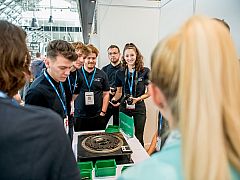

Gyártók The new Vice-Rector of Kecskemét College concentrates not only on the new Mercedes










Like the big companies, Daimler is basically supports the local interests, it means that the company wants to satisfy its needs from the close surroundings. And it is also true if we think about the delivered components, the labour force and the education, too – said professor László Palkovics, who is the strategic vice-rector of Kecskemét College. He wants to concentrate on all the three faculties.
For the 2010/2011 school year, nearly 1200 students have been admitted to the three-faculty Kecskemét College. Most of them (about 600 students) applied for the Faculty of Mechanical Engineering and Automation(GAMF), where the most popular courses are the Mechanical Engineering and Computer Engineering (with 238 and 202 freshmen).The Teacher Training faculty starts with 367 students, the Horticultural Faculty starts with 220 first graders (44 of them have applied to the Master Course).
 |
| Professor László Palkovics |
Since September a new strategic vice-rector has been working at the university, professor László Palkovics, who is from the field of car profession. At the end of last year he said, stirring up a little storm, that engineering had been attenuated in Hungary.
– Has the level of engineering improved, yet?
During this time neither my opinion nor the level of education could really change. I think there is no engineer ‘in general’, the world is much more complicated, so a profession must be studied completely. Being a product designer engineer is not enough; it’s hard to do something with it. It isn’t good if our young professionals have wide but low knowledge. If a mechanical engineer gets the maximal level of education, I think plus 5-10 percent of energy is enough to be able to lead projects because he has a well-founded professional basis to it.
– So you worry about not only the level of engineering but the number of students.
I think rightly, the number of ages 18 to 22 will continuously reduce in further years, and like in many other fields, the strong dominance of Budapest and the adherence to the far-famed institutes like the Budapest University of Technology and Economics (BME) will predominate in this field as well. It is a great challenge for Kecskemét College, though the concept of the Automotive Competence Centres is being formed at the level of coordination. That is to say, the higher education institutes in the five Automotive Centres – in Győr, Veszprém, Budapest, Miskolc, and Kecskemét – share those fields where they want to build a strong competence and they also work together. However, as I am the vice-rector of three faculties, I would like to have a closer relationship with the Szeged University too.
 |
– The preparedness of the applicants isn’t all right. Do you agree with it?
Unfortunately the education of Maths and Physics has almost disappeared from the secondary schools, so the applicants have noticeably weaker foundation then earlier. We don’t want to and even we can’t compensate this lack of knowledge, but we have to handle it. Fortunately I see the intension that Maths and Physics come back to the secondary schools, and there is also an aim to increase the level of education of these subjects. Regarding the entrance examination, the situation has improved somewhat compared with last year, however this improvement hasn’t been significant yet.
– Has the effect of the new Mercedes Factory been felt on the Faculty of GAMF (Mechanical Engineering and Automation )?
Certainly the effect of the Mercedes Factory has been increasing, but we need a very conscious marketing strategy to keep it in progress, what is more, to increase the interest to it. It is helped by our programme; from September of the next year we would like to start Vehicle Engineering Training. And it’s a great step towards the realization that the consortium led by Kecskemét College, together with its project partners AIPA (Great Hungarian Plain Industry Development Non-profit Public Benefit Ltd.) and BME (Budapest University of Technology and Economics), has won 256 million HUF for developing the curriculum of the Vehicle Engineering Training. In a project-starting meeting I said that the human resource managers of Mercedes Benz had been astonished by the lack of the proper higher professionals. The task of satisfying these market expectations and needs falls on Kecskemét College. Starting of the Vehicle Engineering Training, team of professionals will get graduation at the College who will be marketable for not only Mercedes Benz, but for both the suppliers and other automotive businesses too.
– Many people are afraid of that Mercedes will work with no Hungarian suppliers. Do you share this opinion?
No, in medium- and long-term I don’t think so at all. Like other big companies, Daimler is basically supports the local interests, it means that the company wants to satisfy its needs from the close surroundings. And it is also true if we think about the delivered components, the labour force, their education and a great number of services, too. I think Daimler wants to get most parts of their components from the region, increasing with it the number of the settler suppliers. Not only at Mercedes, but at their suppliers, there is a growing demand for the engineers who are able to operate and develop the products. These demands must be satisfied by new or re-trained engineers – Kecskemét College will have a very important role in this process. The idea of getting things from the very close environment is valid for the activity which is needed for the production, but also for the outsourced technical support. It could strengthen our position.
 |
| Kecskemét College |
– Will Kecskemét College be able to meet these challenges?
We will do our best to take advance of it. We have to employ qualified teachers and researchers from universities and academic institutes, from the industry and even from abroad. We would like to call back home those PhD colleagues who are connected with Kecskemét, and in this case I can inform you of a success: two qualified professionals have already transferred to our College. Of course all these steps cost a lot of money, and of course it doesn’t work without students. So we must make the university marketable. Regarding the example of Győr, we can achieve this in the most effective way if we have resource to the support of Daimler with conscious marketing strategy. The promotion campaign of the College and the local education could start even in primary schools, and we must integrate the Teacher Training College into this programme.
– Could you share something with us of your vice-rector strategy?
The aim of creating this post is to have a professional, who sees the education and the whole institution from other point of view and in a different way. We have to draw goals for 5, 10 and 20 years. The task of the shortest period is that Kecskemét College should be able to satisfy the demands for the education, and it should become marketable. We have to train professional engineers, not scientists. Substantive Research and Innovation activity will have to be formed within a ten-year period so that it pulls the education. And after 20 years Kecskemét College may become the dominant university of Central Europe.
– Kecskemét College is going to organize a great event on 24th September. Could we know something about the details?
Industry and Higher Education will meet on this event. There will be Audi, General Motors, Suzuki, ZF Hungary Ltd., and I could list the other companies. Those five universities which have Automotive Training Courses (they were listed above) are curious about that, and they would like to harmonize about that, what the supplier sector expects from the present-day Hungarian higher education. We hope we will have an effective dialogue, and we rely on the participation of the government.
Dr. László Palkovics
 |
In 1984, he began his university studies at the Budapest University of Technology Faculty of Mechanical Engineering, where in 1989 he obtained a degree in engineering. Between 1989 and 1991, he was a participant of the Certification Committee of the Academy of Sciences Doctoral Fellows program, and he had completed his PhD here. He considers József Bokor, Gábor Stépán and Pál Michelberger his masters.
After obtaining a PhD in BME Department of Motor Vehicles Department of Transportation, he began working as an assistant lecturer, and then in 1992, as an assistant professor. In 1994, he was appointed associate professor and head of department. He was only thirty-five years old, when he was awarded a university teaching appointment in 2000. He led the department until 2002. Meanwhile, between 1993 and 1994 he was a researcher of the Automotive Technology Centre of the Canadian Research Council. Also in 1994, he became a research fellow of Computer and Automation Research Institute (SZTAKI) of the Hungarian Academy of Sciences (MTA).
In 1995, he was appointed Development Director of Research and Development Institute for Electronic Systems of the Knorr-Bremse’s (German manufacturer of braking system) Hungarian subsidiary. Between 2001 and 2003 he was the director of the European electronics development in Germany and then in 2003, he was appointed the European director of research and system engineering.
In 1993, he defended his candidate thesis of technical sciences, in 1998, his MTA doctoral thesis. In 2000, he habilitated. In 2007, he was elected a corresponding member of the Hungarian Academy of Sciences. Previously he had been a member of the Institute of Mechanical Engineering Committee of the MTA. His research areas are dynamics and stability of the vehicles, controlled vehicle systems, intelligent vehicle- and carriageway-systems, and applied control theory.
Awards and Prizes
Széchenyi Prize (2001)
Bánki Donát Jubilee Award (2009)
Kiemelt Partnereink